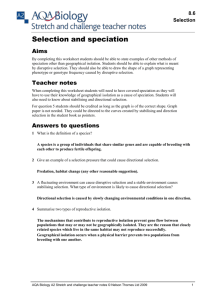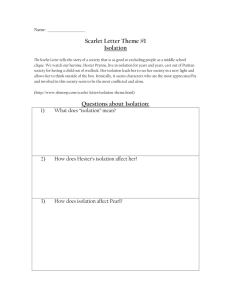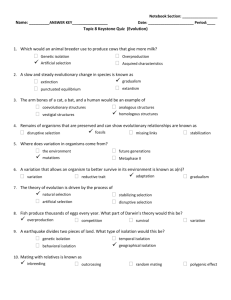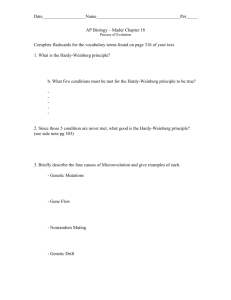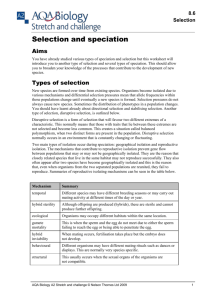BIO 170 General Biology I Spring 2015 Freeman Lecture Exam 1 1
advertisement
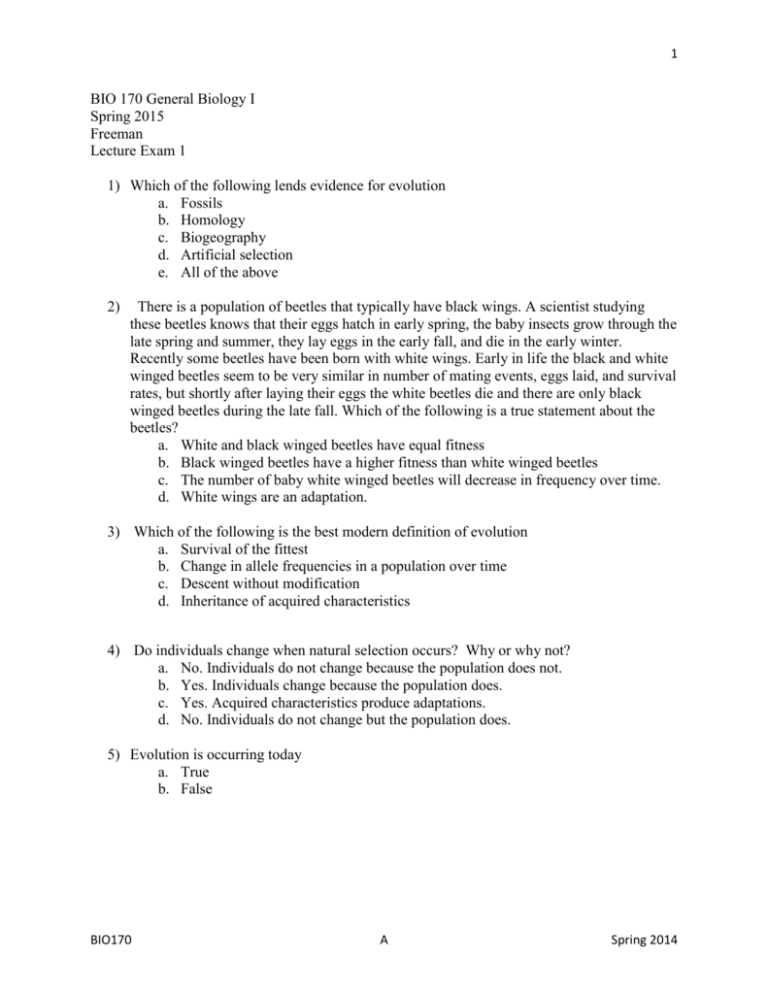
1 BIO 170 General Biology I Spring 2015 Freeman Lecture Exam 1 1) Which of the following lends evidence for evolution a. Fossils b. Homology c. Biogeography d. Artificial selection e. All of the above 2) There is a population of beetles that typically have black wings. A scientist studying these beetles knows that their eggs hatch in early spring, the baby insects grow through the late spring and summer, they lay eggs in the early fall, and die in the early winter. Recently some beetles have been born with white wings. Early in life the black and white winged beetles seem to be very similar in number of mating events, eggs laid, and survival rates, but shortly after laying their eggs the white beetles die and there are only black winged beetles during the late fall. Which of the following is a true statement about the beetles? a. White and black winged beetles have equal fitness b. Black winged beetles have a higher fitness than white winged beetles c. The number of baby white winged beetles will decrease in frequency over time. d. White wings are an adaptation. 3) Which of the following is the best modern definition of evolution a. Survival of the fittest b. Change in allele frequencies in a population over time c. Descent without modification d. Inheritance of acquired characteristics 4) Do individuals change when natural selection occurs? Why or why not? a. No. Individuals do not change because the population does not. b. Yes. Individuals change because the population does. c. Yes. Acquired characteristics produce adaptations. d. No. Individuals do not change but the population does. 5) Evolution is occurring today a. True b. False BIO170 A Spring 2014 2 6) Over long periods of time, many cave-dwelling organisms have lost their eyes. Tapeworms have lost their digestive systems. Whales have lost their hind limbs. How can natural selection account for these losses? a. Natural selection cannot account for losses, but accounts only for new structures and functions. b. Natural selection accounts for these losses by the principle of use and disuse. c. Under particular circumstances that persisted for long periods, each of these structures presented greater costs than benefits. d. The ancestors of these organisms experienced harmful mutations that forced them to lose these structures. 7) About thirteen different species of finches inhabit the Galapagos Islands today, all descendants of a common ancestor from the South American Mainland that arrived a few million years ago. Genetically, there are four distinct lineages, but the thirteen species are currently classified among three genera. The first lineage to diverge from the ancestral lineage was the warbler finch (genes Certhidea). Next to diverge was the vegetarian finch (genus Camarhynchus), followed by five tree finch species (also in genes Camarhynchus) and six ground finch species (genus Geospiza). If the six ground finch species have evolved most recently, then which of these is the most logical prediction? a. They should be limited to the six islands that most recently emerged from the sea. b. Their genomes should be more similar to each other than are the genomes of the five tree finch species. c. They should share fewer anatomical homologies with each other than they share with the tree finches. d. The chances of hybridization between two ground finch species should be less than the chances of hybridization between two tree finch species. 8) Darwin developed his theory of natural selection based on all the following observations EXCEPT a. Individuals vary in the traits they possess b. Traits are heritable c. Individuals produce enough offspring to replace themselves d. Resources are limited 9) Fitness refers to a. The number of offspring an individual leaves to the next generation b. The strength on an individual c. The health on an individual d. All of the above 10) The similarity of the bone structure in a horses forelimb and a bat wing is an example of a. Structural homology b. Structural homoplasy c. Developmental homology d. Developmental homoplasy BIO170 A Spring 2014 3 11) Given a population that contains genetic variation, what is the correct sequence of the following events under the influence of natural selection? 1. Well-adapted individuals leave more offspring than do poorly adapted individuals 2. A change occurs in the environment 3. Genetic frequencies within the population change 4. Poorly adapted individuals have decreased survivorship a. 2 4 13 b. 4 2 13 c. 4 1 23 d. 4 2 31 e. 2 4 31 12) Long necks make it easier for giraffes to reach leaves high on tress, while also making them better fighters in “neck wrestling” contests. In both cases, which kind of selection appears to have made giraffes the long-necked creatures they are today? a. Directional selection b. Disruptive selection c. Stabilizing selection 13) After the drought of 1977, researchers on the island of Daphne Major hypothesized that medium ground finches that had large, deep beaks, survived better than those with smaller beaks because they could more easily crack and eat the tough Tribulus cistoides fruits. If this hypothesis is correct, what would you expect to observe if a population of these medium ground finches colonizes a nearby island where T. cistoides is the most abundant food for the next 1000 years? Assume that (1) even the survivors of the 1977 drought sometimes had difficulty cracking the tough T. cistoides fruits and would eat other seeds when offered a choice; and (2) food availability is the primary limit on finch fitness on this new island. a. Evolution of yet larger, deeper beaks over time b. Evolution of smaller, pointier beaks over time c. Random fluctuations in beak size and shape d. No change in beak size and shape 14) Genetic drift __________. a. Produces changes in allele frequencies that are not adaptive b. Is most pronounced in large populations c. Cannot occur if mating is random d. Can lead to fixation of alleles only. BIO170 A Spring 2014 4 15) How do stabilizing and disruptive selection differ? a. With stabilizing selection, the average phenotype for a trait does not change. With disruptive selection, the average phenotype for a trait changes. b. Stabilizing selection produces adaptation. Disruptive selection is non-adaptive. c. Stabilizing selection reduces the amount of variation in a trait. Disruptive selection increases the amount of variation in a trait. d. With stabilizing selection, extreme individuals have high biological fitness. With disruptive selection, extreme individuals have low biological fitness. 16) Knowing that there are 30% blue eyed individuals in the population and 70% brown eyed individuals tells you the a. Genotype ratio b. Phenotype ratio c. Allele ratio d. Gene pool 17) Gene flow between populations ______. a. Increases the differences between the populations. b. Causes the populations to become more similar. c. Either a or b could occur. 18) An earthquake decimates a ground-squirrel population, killing 98% of the squirrels. The surviving population happens to have broader stripes, on average, than the initial population. If broadness of stripes is genetically determined, what effect has the groundsquirrel population experienced during the earth quake? a. Directional selection b. Disruptive selection c. A founder event d. Genetic drift e. Gene flow 19) Mutation is the only creative force in evolution. a. True b. False 20) Genetic variation _______. a. Is created by the direct action of natural selection b. Arises in response to changes in the environment c. Must be present in a population before natural selection can act upon the population d. Tends to be reduced when diploid organisms produce gametes BIO170 A Spring 2014 5 21) Refer to the picture to the right. Which of the following forms a monophyletic group? a. A, B, C, D b. C and D c. D, E, and F d. E, F, and G e. All of the above 22) There is an island in the middle of a large river that houses a large population of ants. Damming of the river causes the island to flood and only the highest points of the island are now above water. The ants cannot swim, so are now in multiple isolated populations. Which of the following best describes this event? a. Isolation by dispersal b. Isolation by vicariance c. A form of sympatric speciation d. Speciation will not occur in this case because of gene flow 23) Natural selection for traits that keep distinct populations from reproducing with each other is called reinforcement. When is reinforcement beneficial? a. When prezygotic isolating mechanisms are in place b. When the environment is changing c. When gene flow is low d. When hybrids have lower fitness than either parent population e. Reinforcement is beneficial under all the above conditions 24) Martin Wikelski and L. Michael Romero measured the snout-to-vent (anus) length of Galapagos marine iguanas and observed the percent survival of different-sized animals, all of the same age. The graph shows the log snout-vent length (SVL, a measure of overall body size) plotted against the percent survival of these different size classes for males and females. What type of selection for body size appears to be occurring in these marine iguanas? a. Directional selection b. Stabilizing selection c. Disruptive selection d. You cannot determine the type of selection from the information above. BIO170 A Spring 2014 6 25) Wikelski and Romero found that large marine iguanas had higher reproductive success than smaller iguanas did. However, the large iguanas were generally in poor body condition because they could not eat enough; at higher temperatures their foraging efficiency improved, allowing them to eat more. Thus, Wikelski and Romero hypothesized that iguana size will _____ as global warming gradually increases air and water temperatures in the Galapagos Islands. a. Increase b. Decrease c. Stabilize around the mean body size d. Remain unchanged, it is not clear that body size increases fitness 26) Currently the only predators of Galapagos marine iguanas are Galapagos hawks. Iguana body size is not correlated with risk of hawk predation, although small iguanas can sprint faster than large iguanas. If predators (for example, cats) that preferably catch and eat slower iguanas are introduced to the island, iguana body size is likely to ____ in the absence of other factors; the iguanas would then be under ____ selection. a. Increase; directional b. Increase; disruptive c. Decrease; directional d. Decrease; disruptive e. Stay the same; stabilizing 27) All of the following are prezygotic reproductive isolation mechanisms EXCEPT a. Behavioral isolation b. Temporal isolation c. Mechanical isolation d. Hybrid sterility 28) Males of different species of the fruit fly Drosophila that live in the same parts of the Hawaiian Islands have different elaborate courtship rituals. These rituals involve fighting other males and making stylized movements that attract females. What type of reproductive isolation does this represent? a. Habitat isolation b. Temporal isolation c. Behavioral isolation d. Gametic isolation 29) A gametic barrier refers to a. Vicariance b. Incompatibility between egg and sperm c. Incompatibility between male and female reproductive morphology d. Gametes maturing a different times BIO170 A Spring 2014 7 30) Which of the following evidence most strongly supports the common origin of all life on Earth? All organisms _______. a. Require energy. b. Use essentially the same genetic code c. Reproduce d. Show heritable variation e. evolve 31) The morphospecies concept _________. a. Can be applied to fossil species b. Is used when the criterion of reproductive isolation cannot be applied c. Relies on morphological similarity to determine evolutionary lineages d. All of the above. 32) Which of the following statements about adaptive radiation is correct? a. Adaptive radiation occurs within a single lineage. b. Adaptive radiation occurs very slowly over time. c. Adaptive radiation occurs in species that live in one habitat. d. Adaptive radiation occurs in the presence of competitors. 33) Which statement is correct? a. A synapomorphy is an ancestral trait. b. Synapomorphies identify monophyletic groups. c. Synapomorphies are examples of homoplasy. d. All of the above. 34) In the diagram to the right, the arrow points to a. A node b. A tip c. A branch d. A lineage 35) Logically, which of these should case the most doubt on the relationships depicted by an evolutionary tree? a. None of the organisms depicted by the tree at the same foods. b. Some of the organisms depicted by the tree had lived in different habitats. c. The skeletal remains of the organisms depicted by the tree were incomplete (some bones were missing) d. Transitional fossils had not been found e. Relationships between DNA sequences among the species did not match relationships between skeletal patterns. BIO170 A Spring 2014 8 36) Populations must be physically separated in order to evolve into separate species. a. True b. False 37) The common edible frog of Europe is a hybrid between two species, Rana lessonae and R. ridibunda. The hybrids were first described in 1758 and have a wide distribution, from France across central Europe to Russia. Both male and female hybrids exist, but when they mate among themselves, they are rarely successful in producing offspring. What can you infer from this information? a. Postzygotic isolation exists between the two frog species. b. Prezygotic isolation exists be3tween the two frog species. c. These two species are likely in the process of fusing back into one species d. The hybrids form a separate species under the biological species concept/ 38) The phenetic approach to constructing phylogenies is based on a. Identifying Synapomorphies between lineages b. Overall similarity of lineages c. Phenotypic ratios d. All of the above 39) Which of the following trees, if any, depicts the same relationship among species as shown above? a. b. c. BIO170 A Spring 2014 9 40) A modified trait (compared to the ancestral condition) is referred to as a. A homology b. A homoplasy c. A derived trait d. A synapomorphy 41) Similar gill pouches in embryos of chick, human and cat are an example of ____. a. Structural homology b. Developmental homology c. Genetic homology d. Inheritance of acquired characteristics e. More than one of the above is true. 42) A farmer uses triazine herbicide to control pigweed in his field. For the first few years, the triazine works well and almost all the pigweed dies; but after several years, the farmer sees more and more pigweed. Which of these explanations best explains what happened? a. The herbicide company lost its triazine formula and started selling poor-quality triazine. b. Natural selection caused the pigweed to mutate, creating a new triazine-resistant species. c. Triazine-resistant pigweed has less-efficient photosynthesis metabolism. d. Triazine-resistant weeds were more likely to survive and reproduce. 43) Claytonia virginica is a woodland spring herb with flowers that vary from white to pale pink to bright pink. Slugs prefer to eat pink-flowering over white-flowering plants (due to chemical differences between the two), and plants experiencing severe herbivory are more likely to die. The bees that pollinate this plant also prefer pink to white flowers, so that Claytonia with pink flowers have greater relative fruit set than Claytonia with white flowers. A researcher observes that the percentage of different flower colors remains stable in the study population from year to year. Given no other information, if the researcher removes all slugs from the study population, what do you expect to happen to the distribution of flower colors in the population over time? a. The percentage of pink flowers should increase over time. b. The percentage of white flowers should increase over time. c. The distribution of flower colors should not change. d. The distribution of flower colors should randomly fluctuate over time. 44) 45) 46) 47) 48) 49) 50) BIO170 LEAVE QUESTIONS 4450 BLANK ON YOUR SCANTRON SHEET! A Spring 2014 10 51) Which cells have a nucleus a. Prokaryotic cells b. Eukaryotic cells c. Both prokaryotic and eukaryotic cells 52) Which series depicts groups from most inclusive to least inclusive? a. Phylum – Order – Class – Family b. Order – Phylum – Class – Family c. Family – Class – Order – Phylum d. Phylum – Class – Order – Family 53) Which of the following is the correct depiction of the name for the American Robin (a kind of bird) a. Turdus migratorius b. Turdus Migratorius c. Turdus migratorius d. Turdus Migratorius e. They are all acceptable 54) Which is true about a population a. They can be dispersed over several continents b. They may be composed of numerous species c. They are alive at the same time d. All of the above e. None of the above 55) Endosymbiosis gave rise to a. Mitochondria b. Chloroplasts c. Both a and b 56) Protists and bacteria are grouped into different domains because _____. a. Protists eat bacteria b. Bacteria are not made of cells c. Protists have a membrane-bound nucleus, which bacterial cells lack d. Bacteria decompose protists e. Protists are photosynthetic. BIO170 A Spring 2014 11 57) Imagine that there are 25 different species of protists living in a tide pool. Some of these species reproduce both sexually and asexually, and some of them can reproduce only asexually. The pool gradually becomes infested with disease-causing viruses and bacteria. Which species are more likely to thrive in the changing environment? a. The sexually reproducing species b. The asexually reproducing species c. Sexually and asexually reproducing species are equally likely to thrive 58) Many crustaceans (for example, lobsters, shrimps and crayfish) use their tails to swim, but crabs have reduced tails that curl under their shells and are not used in swimming. This is an example of ____. a. Convergent evolution b. A homologous structure c. Natural selection d. A vestigial trait 59) Refer to the diagram to the right. Where on the phylogenetic tree should the origin of a nuclear envelope appear? a. At the base of all Eukaryotes b. At the base of the Plantae c. At the base of the group Animals d. At the base of the monophyletic group Bikonta e. None of the above is correct 60) Meiosis is characterized by _____ cells giving rise to _______ cells. a. Diploid, diploid b. Haploid, haploid c. Diploid, haploid d. Haploid, diploid BIO170 A Spring 2014 12 61) Protists are a __________ group. a. Paraphyletic b. Monophyletic c. Polyphyletic d. Synapomorphic 62) All protists are unicellular a. True b. False 63) Eukaryotes can be divided into 2 monophyletic lineages based on a. Having a cell wall or not b. Having one or two flagella c. Having chloroplasts or not d. Being multicellular or not e. Having nerve tissue or not 64) In the process of alternation of generations, the _____. a. Diploid organism produces haploid cells by meiosis b. The diploid organism produces a haploid organism by mitosis c. Haploid cells develop into haploid organisms by mitosis d. All of the above are true e. More than one of the above are true 65) Both animals and fungi are heterotrophic. What distinguishes animal heterotrophy from fungal heterotrophy is that most animals derive their nutrition by ____. a. Preying on animals b. Ingesting it c. Consuming living, rather than dead, prey d. Using enzymes to digest their food. 66) According to the evidence collected so far, the animal kingdom is ___. a. Monophyletic b. Paraphyletic c. Polyphyletic d. Euphyletic e. Multiphyletic BIO170 A Spring 2014 13 67) If you think of the tube-within-a-tube body plan as a pipe with a straw inside, where would you expect to find most of the ectodermal, mesodermal, and endodermal germ layers, respectively? a. space inside of straw; straw; space between pipe and straw b. pipe; space between pipe and straw; straw c. straw; space between pipe and straw; pipe d. pipe; straw; space inside of straw 68) What do biologists cite as the primary benefit of the evolution of a coelom in animals? a. the subsequent evolution of segmentation b. a more efficient digestive system, in the form of a tube-within-a-tube c. the hydrostatic skeleton, allowing greater range of motion d. cephalization and the formation of a cerebral ganglion 69) An organism that exhibits cephalization probably also _____. a. Is bilaterally symmetrical b. Has a hydrostatic skeleton c. Is diploblastic d. Has a coelom e. All of the above 70) In deuterostomes the blastopore becomes the a. Mouth b. Anus c. Coelom d. Nervous system 71) Which of the following is a feature of the tube-within-a-tube body plan in most animals? a. The outer tube consists of a hard exoskeleton b. The outer tube consists of digestive organs c. The mouth and anus form the ends of the inner tube d. The two tubes are separated by tissue that comes from embryonic endoderm BIO170 A Spring 2014 14 72) The lineage known as animals are united by the following characteristic a. Lack a cell wall b. Multicellular c. Have neurons d. Heterotrophic e. All of the above 73) Which embryologic tissue gives rise to the nervous system? a. Ectoderm b. Endoderm c. Mesoderm d. They all can give rise to nervous tissue. 74) At which developmental stage should one be able to first distinguish a diploblastic embryo from a triploblastic embryo? a. Fertilization b. Cleavage c. Gastrulation d. Coelom formation e. metamorphosis 75) A brain is a. A ganglion b. Composed of nervous tissue c. Is located anteriorly d. All of the above 76) What was an early selective advantage of a coelom in animals? A coelom ___ a. Contributed to a hydrostatic skeleton, allowing a greater range of motion b. Was a more efficient digestive system c. Allowed cephalization and the formation of a cerebral ganglion d. Allowed asexual and sexual reproduction e. All of the above. 77) Suppose a researcher for a pest-control company developed a chemical that inhibited the development of an embryonic mosquito’s endodermal cells. Which of the following would be a likely mechanism by which this pesticide works? a. The mosquito would develop a weakened exoskeleton that would make it vulnerable to trauma. b. The mosquito would have trouble digesting food, due to impaired gut function. c. The mosquito would have trouble with respiration and circulation, due to impaired muscle function d. The mosquito wouldn’t be affected at all. BIO170 A Spring 2014 15 78) The area of the animal body indicated in the picture below is a. Anterior b. Posterior c. Dorsal d. Ventral 79) How many lecture exams are given in this course a. 2 b. 3 c. 4 d. 5 80) You can make up a quiz in this class. a. True b. False 81) Which of these carries the same weight (is worth the same points) as one lecture exam a. The quiz average b. The mastering biology homework average c. Lab d. More than one of the above is true. 82) More than ___ lecture absences will result in a failing grade in this course. a. 2 b. 3 c. 4 d. 5 e. 6 BIO170 A Spring 2014

